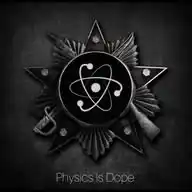
Physics Is Dope – Gaurav's World of Physics
315 subscribers
About Physics Is Dope – Gaurav's World of Physics
Welcome to the "Physics Is Dope – Gaurav's World of Physics" - A Place where the Fun Meets the Physics of Reality! 🚀 Are you a fervent physics enthusiast 🤓, an Einstein in the making 😉, or simply a curious mind 🧠 ready to embark on a cosmic journey through the fascinating realms of the universe? If so, you've just quantum tunneled to the right energy level! 🌠 Here's what you can expect in my dimension-bending channel: 🎥 *Pop Physics Videos*: Dive headfirst into the universe with short and engaging physics videos that will make your brain's particles oscillate with joy. 📚 *Short Essays*: Explore the fascinating side of physics with insightful, bite-sized essays that break down complex theories into digestible nuggets of knowledge. 🌟 *Memes*: Laugh and learn simultaneously with my physics-themed memes that fuse humor and physics in a way that even Schrödinger's cat would approve. 🖼️ *GIFs*: To the point GIFs which explain concepts visually like nothing else. ▶️ *YouTube Recommendations*: Let me bring you cosmic tour guides with handpicked YouTube video recommendations. 🌍 *Physics News*: Stay updated with the latest in the world of physics. 🌌 "Physics Is Dope – Gaurav's World of Physics" is more than just a WhatsApp channel; it's a wormhole to a world where science and fun collide. ⚠️ _*Disclaimer*_ ⚠️ _This WhatsApp channel, specializing in popular science (physics in particular), functions exclusively as a medium for the dissemination of accessible and simplified scientific knowledge. I explicitly disclaim any assertion of providing exhaustive expertise on any subject matter. Followers are earnestly urged to undertake their independent research and scrutiny from reputable sources to cultivate a comprehensive understanding of the topics discussed in this channel._ Remember SCIENCE is FUN!! 🧪 🔬 🔭 ⚗️ 🧫 🧬 🪐 🌡️🩺🦠💉🩻🧲🖥️🧮📐📏👩🔬👨🔬 🌟 *🆕 Wanna get featured? Submit your content now via* [email protected] (it's free).
Similar Channels
Swipe to see more
Posts

*Q: Why can't we measure the potential barrier of a pn-junction by simply using a voltmeter?* A: The potential barrier in a p-n junction cannot be directly measured using a voltmeter because the voltmeter measures the net voltage across the terminals, which is influenced by the metal-semiconductor contact potentials. When a voltmeter is connected to the p-n junction, it forms metal-semiconductor junctions at both ends. These junctions develop their own contact potentials due to differences in work functions between the metal and semiconductor. The contact potentials typically oppose and cancel out the built-in potential of the p-n junction, leading to a net voltage reading of zero in an equilibrium state. This is because the built-in potential is an internal property of the junction and does not produce an external electric field measurable by the voltmeter.

🔍 *What happens to a diode under large forward voltage?* When the forward voltage V on a p-n junction approaches the built-in potential V₀, the barrier almost vanishes, theoretically allowing infinite current. But in real diodes, *practical limitations* kick in: 1️⃣ *Bulk Resistance:* The semiconductor material has a finite resistance, limiting the current flow. 2️⃣ *Ohmic Contact Resistance:* The metal-semiconductor interfaces also contribute resistance. These resistances prevent the barrier from reducing to zero and cap the current, protecting the diode. At high currents, the voltage drop across these resistances dominates, and the diode’s behavior shifts from exponential to *linear*, following Ohm’s Law. ⚡ *Takeaway:* In real-world diodes, resistances ensure stability, keeping the current and I-V characteristics practical under large forward voltages.

*Altermagnetism* is a revolutionary discovery in physics, bridging ferromagnetism and antiferromagnetism. Found in certain crystals, it creates spin-splitting in electrons *without* net magnetization, thanks to unique symmetries in the material's structure. This opens doors for ultra-efficient *spintronics*—technology harnessing electron spins instead of charges. Imagine faster, smaller, and energy-saving devices! Unlike conventional magnets, altermagnetic materials resist interference from magnetic fields, making them ideal for robust quantum tech. A breakthrough blending theoretical elegance and real-world impact, altermagnetism is reshaping our understanding of magnetism. 🌌✨ #Altermagnetism #Spintronics #PhysicsInnovation #QuantumTech

Ever wondered why optical instruments, like telescopes or microscopes, can't infinitely zoom into tiny details? 🌌🔬 The limit lies in the *wave nature of light*—called the *diffraction limit*. When light passes through a circular aperture (like a lens or mirror), it spreads out into a diffraction pattern with a central bright spot, the *Airy disk*, surrounded by dim rings. The smaller this disk, the better the resolution. The *Rayleigh criterion* defines this limit: θ = 1.22(λ/D), where λ is the wavelength of light, and D is the aperture diameter. A larger aperture or shorter wavelength leads to sharper images. 🚀 Diffraction-limited instruments, like the Hubble Space Telescope, achieve the maximum theoretical resolution, producing stunningly detailed images of the universe. 🌟 In everyday optics, it explains why lens quality and size are crucial for clarity in cameras, microscopes, and telescopes. #Physics #Optics #Space

There was complete freedom of teaching and learning in German universities, with no class examinations, and no control of students. The University just offered lectures and the student had to decide for himself which he wished to attend. --- Max Born

*Inverse Compton scattering* is a process where high-energy electrons transfer some of their energy to low-energy photons, resulting in an increase in the photons' energy. This typically occurs in astrophysical environments, such as around pulsars or in the vicinity of black holes, where high-energy electrons are abundant. The process is essential in explaining the presence of high-energy gamma rays observed in various cosmic phenomena and contributes significantly to our understanding of the universe.

https://www.linkedin.com/posts/sciastra_womeninscience-inspiration-mit-activity-7287373242808332288-azC8?utm_source=share&utm_medium=member_android

🌟 *Particle Physics Saving Lives!* 🌟 Did you know that *Positron Emission Tomography (PET)*, a cutting-edge medical imaging tool, relies on principles of particle physics? PET scans use positrons and gamma rays to create 3D images of metabolic activity, aiding in early cancer detection, monitoring brain disorders like Alzheimer’s, and evaluating heart health. This powerful blend of physics and medicine showcases how fundamental science translates into life-saving technologies for better healthcare.

*The Best Father-Son Duo in Science* *J.J. Thomson* discovered the electron in 1897, proving it to be a *particle* and earning the 1906 Nobel Prize. His son, *G.P. Thomson*, later demonstrated that electrons also behave as *waves*, earning his own Nobel in 1937. Together, they revealed the dual nature of electrons, shaping the foundation of quantum mechanics. A remarkable father-son legacy, each contributing uniquely to our understanding of the atomic world!

W. L. Bragg, the pioneer in x-ray diffraction, gave the following loose but vivid interpretation of the wave-particle duality: _“The dividing line between the wave and particle nature of matter and radiation is the moment ‘now.’ As this moment steadily advances through time it coagulates a wavy future into a particle past. . . . Everything in the future is a wave, everything in the past is a particle.” If “the moment ‘now’ ” is understood to be the time a measurement is performed, this is a reasonable way to think about the situation._ The philosopher Søren Kierkegaard may have been anticipating this aspect of modern physics when he wrote, _“Life can only be understood backwards, but it must be lived forwards.”_













